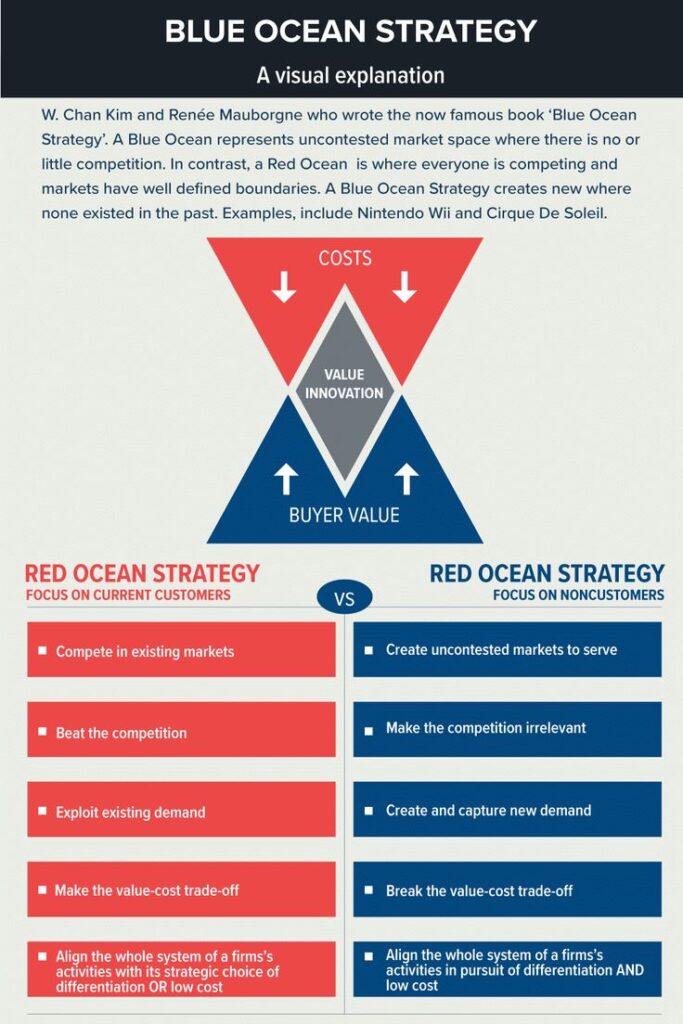В конкурентната среда на днешния бизнес свят, независимо дали управлявате малък стартъп, изкачвате се по корпоративната стълбица или се стремите да постигнете успехи в своята област, реалността е ясна: конкуренцията е безмилостна. Но какво би станало, ако имаше начин да се издигнете над съперниците си и да доминирате на пазара? Появете се на бял свят със стратегията „Син океан“ – подход за трансформация, който може да ви послужи като тайно оръжие за разгръщане на бизнес потенциала.
Червеният океан срещу Синия океан: Познаване на бизнес потенциала
Представете си, че ви предстои гмуркане. Инструкторът ви предлага два варианта:
гмуркане в чист, динамичен океан, изпълнен с живот и пространство за изследване.
Да се гмурнете в претъпкано, мътно море, в което се състезавате с други гмуркачи, за да зърнете нещо стойностно.
Повечето от нас биха избрали първия вариант, нали? Точно такова трябва да е усещането при стартирането на бизнес. За съжаление, много предприемачи се оказват във втория вариант – червен океан, който ограничава техния бизнес потенциал. според Стратегията за синия океан пазарите могат да бъдат категоризирани в два различни океана:
Червен океан: Това е мястото, където работят повечето предприятия. Той е наситен, правилата са установени и компаниите се конкурират ожесточено за едни и същи клиенти. Вследствие на това печалбите се свиват, а растежът е в застой, което възпрепятства цялостния бизнес потенциал.
Син океан: Това е неизползваното пазарно пространство, където конкуренцията е без значение. Правилата не са дефинирани и има широко пространство за растеж и рентабилност.

Тайната: стойностни иновации и бизнес потенциал
В основата на стратегията „Син океан“ е иновацията на стойността. Тази мощна концепция гласи, че можете да предоставите по-голяма стойност на клиентите, като същевременно намалите разходите, като по този начин увеличите максимално бизнес потенциала си. Може би се чудите: „Как може да се постигне по-висока стойност при по-ниски разходи?“ Отговорът се крие в иновативното мислене.
Казусът с виното Yellowtail: Урок по бизнес потенциал
Ярък пример за стойностна иновация е успехът на виното Yellowtail. На силно конкурентния пазар на вино в САЩ Casella Wines, австралийска компания, успява да създаде първото място по внос на вино чрез стратегическа иновация на стойността.Те използват два ключови инструмента от стратегията „Син океан“:
Стратегическо платно: Този инструмент помага да се визуализира какво предлагат конкурентите в сравнение с това, което клиентите наистина ценят, предоставяйки моментна снимка на пазарния пейзаж и разкривайки бизнес потенциала.
Рамка от четири действия: Тази рамка ви подтиква да зададете четири критични въпроса, за да създадете своя син океан:
Елиминирайте: Какви фактори можете да премахнете, които индустрията приема за даденост?
Намалете: Кои фактори трябва да се намалят под стандартите на индустрията?
Повишете: Кои фактори трябва да се повишат над стандартите в отрасъла?
Създаване: Какви нови елементи можете да въведете, които индустрията никога не е предлагала?
Прилагайки тази рамка, Casella Wines направи стратегически избор, който ги отличи от конкуренцията и отключи значителен бизнес потенциал. Те елиминираха сложността и отлежаването, намалиха избора си на вина само до два варианта, повишиха цените си малко над бюджетните вина и създадоха просто, лесно за пиене вино, което се харесва на хората, които не пият вино. Само за две години Yellowtail се превърна в най-бързо развиващата се марка вино в САЩ и в номер едно сред вносните вина.
Създаване на собствен син океан: Шестте пътя към бизнес потенциала
Основният въпрос е: как да откриете собствения си син океан и да разгърнете бизнес потенциала си? Ето шест приложими стратегии:
Погледнете отвъд функционалната и емоционалната привлекателност: Ако вашият бранш се фокусира върху функционалността, помислете за добавяне на емоционално измерение. Например, Starbucks превърна кафето в преживяване.
Разгледайте алтернативни индустрии: Помислете отвъд непосредствената си индустрия. Какви алтернативи използват клиентите в момента? Хенри Форд направи революция в автомобилната индустрия, като наблюдаваше практиките в други сектори.
Разгледайте допълващи се продукти и услуги: Обмислете цялостното преживяване на клиента. Philips установи, че проблемът с варенето на чай във Великобритания не е в чайника, а във варовиковия камък във водата, което ги накара да създадат ново решение, което увеличи потенциала им.
Разгледайте различните стратегически групи: Анализирайте различните сегменти в рамките на вашата индустрия и определете какво кара клиентите да преминават на по-висока или по-ниска позиция. Марката Lexus на Toyota обединява лукса с достъпността.
Разгледайте веригата на купувачите: Разгледайте различните заинтересовани страни, участващи в процеса на купуване – потребители, влиятелни лица и купувачи. Ново Нордиск измества фокуса на инсулиновите продукти от лекарите към пациентите, създавайки нов пазар със своя NovoPen.
Поглед във времето: Тенденциите формират индустриите. Предвиждайте какво ще се случи след това, както Netflix направи с възхода на стрийминга, и позиционирайте бизнеса си така, че да се възползвате от бъдещите възможности.

Заключение: Гмуркане в синия океан за максимален бизнес потенциал
В свят, в който конкуренцията се усеща навсякъде, стратегията „Син океан“ ви дава възможност да се освободите от традиционните ограничения. Като възприемате иновациите в стойността и мислите по различен начин, можете да обособите свое уникално място в
За повече информация относно стратегията „Син океан“ можете да кликнете и да прочетете книгата: